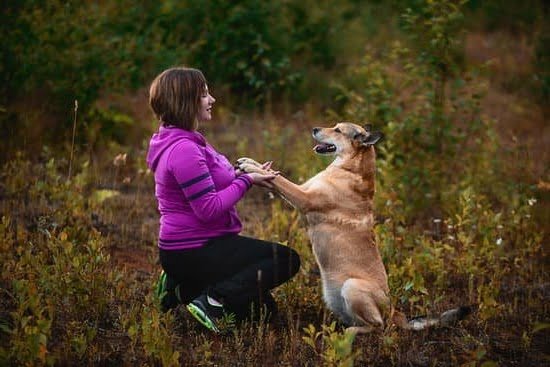Introduction
When it comes to training a dog with behavior issues, the first step is to determine what the specific behaviors are and then set individualized training goals. Identifying problem behavior such as barking excessively, chewing on furniture, jumping up on people, or scratching at doorways can help you identify behavioral problems that may require special attention. Once you have identified the problem behavior, the next step is to develop a plan to modify the behavior through training. This plan should include establishing clear and achievable goals for each behavior, developing a timeline for teaching new behaviors and rewards that will be used for reinforcing desirable qualities. Additionally, consistent and predictable routines are important as dogs learn most effectively when there is an established routine every day. Finally, it is important to allow enough time for success and use positive reinforcement when rewarding acceptable behaviors from your pet. With commitment and consistency in following this approach along with patience and understanding of your pets needs, you can help transform bad behavior into good habits over time.
Responsible Ownership & Developing Consistent Expectations
Training a dog with behavior issues takes time and consistency, but it doesn’t have to be overwhelming or difficult. Being a responsible dog owner is the first step in making any progress with an out-of-control pup. The key is to remember that dogs don’t understand human language, so providing clear expectations and boundaries from day one will help immensely in the long run.
When you first bring your pup home, it’s important to establish some basic rules for behaviour in the house and yard, as well as outside in public spaces. These rules should be consistent at all times so your pet can learn what is acceptable and what isn’t while they adjust to their new environment. Reward desirable behaviours like sitting or staying when asked; but also, don’t reward negative behaviours like barking or jumping.
Teaching basic commands such as sit, stay, heel and down are simple ways to begin training your pup with behavior issues. Stay calm when repeating commands and use rewards for desired actions – treats are often good motivators! Use short training sessions throughout the day for greater success rather than one long session – even as short as five minutes will get results. Be patient and understanding during each session; it is important that your dog feels comfortable learning new commands instead of feeling scared or anxious. If you find yourself becoming impatient or frustrated during a session, take a break from working with your pup until you can remain calm and collected while interacting with them again.
It’s important to remember that all dogs require consistency – dogs thrive on routine – therefore it’s essential to provide clarity through daily exercise, meal times, playtime, potty breaks and sleep time so they know exactly what will happen next and are not confused or anxious while learning new behaviors. Additionally, positive reinforcement (praise!) goes a long way when training pets with behavioral issues; this shows your pup that they have done something right which encourages them to repeat these behaviors again in the future! Finally, ensure both you and your dog get plenty of rest between training sessions – tiredness can cause frustration on both ends of the leash!
Recognizing Your Dog’s Unique Characteristics
Before attempting to train a dog with behavior issues, it’s important to first recognize the unique characteristics of your pet. Take some time getting to know your dog; observe how they react to different environments, people, and situations. Establish communication with your dog by learning the sounds they make and the body language they demonstrate. Additionally, look into the breed of your dog— specific breeds may respond differently to certain training techniques compared to others. Knowing these key points will help guide you in better understanding how your pup thinks and behaves, which is essential in successful training.
Creating an Effective Training Plan
Training a dog with behavior issues can take some patience and perseverance, but it is definitely possible. The key to success when training these difficult dogs is creating an effective plan. Start by identifying the particular behaviors that are problematic. This could include aggression towards other dogs or people, jumping up, barking excessively or chewing on items around the house. Once you know what behaviors need to be addressed, you can begin scheduling daily training sessions with your dog.
Start each session by setting expectations for how your dog should behave in each situation. For example, if you’re training them not to bark when someone comes to the door then reward any quiet time they have with a treat or praise. It’s important to remain consistent when addressing certain behaviors and make sure you always provide positive reinforcements such as treats and vocal praises when they respond correctly.
In addition to positive reinforcement, it can also be helpful to teach basic obedience commands such as sit, stay and come so that your dog will respond better in certain situations. Incorporate exercises such as repeating these commands often during training sessions so that your pup learns quickly and remembers easily. If there are any particularly challenging behaviors, like aggression or destructive tendencies, then further research may be necessary in order to create a strategy for providing corrective feedback without punishing them for their actions.
Lastly, consider enlisting the help of a professional pet trainer if available near you. Professional trainers are experienced with problem behavior in dogs and can help troubleshoot any issues that may arise during training sessions and provide ongoing support along the way.. With patience, consistency and an effective plan of action for addressing troublesome behavior patterns, anyone can successfully train their dog with behavior issues.
Techniques for Modifying Unwanted Behavior
Training a dog with behavior issues can be difficult, but if you approach the process with patience and consistency, positive change is possible. First, it is important to identify the root cause of the problem behavior so that you can develop an appropriate treatment plan. The plan should include positive reinforcement as well as strategies for correcting unwelcome behaviors. To train your dog effectively, reward desirable behaviors while ignoring or punishing inappropriate ones, such as growling or jumping. You may also want to increase the difficulty of commands gradually so that the dog can successfully practice good habits on a regular basis.
When implementing training, remember that consistency is key—make sure everyone in the household enforces the same rules and practices for your pet so that it builds reliable expectations about its behavior. Additionally, establish clear boundaries and consequences when necessary—for instance if your dog breaks a rule like jumping on the couch. This will help reinforce the rules and give your pup a sense of structure and security within its environment. Finally, reward based training works best when accompanied by plenty of patience and praise—so keep those treats handy! With consistent and gentle training, soon you’ll have a loyal companion with improved behavioral issues!
Effective Behavioral Training & Socialization Exercises
Training a dog with behavioral issues can take some effort, but it is possible. The first step to successful training and socialization is to identify the behaviors that need changing or improving. Common behavioral issues include aggression, fearfulness, disobedience, excessive barking, destructive behavior, and jumping. Once you have identified which behaviors need training, it’s important to create a plan of action and stick to it. This should include rewards for good behavior, consistency in rules and expectations, an understanding of your dog’s needs, time management (set aside just a few minutes per day for dedicated training), and patience.
It is also important to remember that any changes in behavior will require consistent repetition over time and will not be achieved overnight; however if done correctly each session should bring small improvements which will eventually add up to major successes and a better-behaved pet.
Once you have created a plan of action for effective training, there are many exercises available which can help improve problem areas and sharpen your pup’s obedience skills If a dog shows signs of aggression or fearfulness towards people or other animals then desensitization exercises should be practiced often to help the animal become more comfortable in social situations. If a pup is having trouble following commands or obeying their owner during walks then leash training should be implemented as soon as possible, along with basic commands such as ‘sit’ and ‘stay’ as well as more skilled commands such as ‘heel’ or ‘come’. Additionally mentally stimulating activities like agility courses or interactive toys can help keep your pet busy when they get bored or destructive – using treats as rewards for good behavior further enhances these experiences. Finally utilizing positive reinforcement tools such as clickers can effectively increase desirable behaviors while decreasing those that are less than desirable when used correctly; this includes verbal praise, treats and head scratches once behaviors are displayed correctly in addition to not rewarding undesired behavior by ignoring the pet altogether. Remember your furry friend needs love too so try to strike a balance between discipline and positive attention during these times – happy training!
Strategies for Dealing with New Situations
If your dog has behavior issues, the first thing you need to do is identify what type of behavior is causing the issue. Is your dog barking too loud? not listening to you? exhibiting aggressive behaviors? Once you pinpoint the issue, you can begin developing a plan on how to train and modify the behavior.
The next step is to prepare for any new situations that may arise. Start by taking note of any triggers for the problem behavior. Are there certain people or places that cause your dog to become stressed or reactive? Make sure that if your plan entails introducing your dog to something new, that it’s done slowly, calmly, and in a good environment with a lot of positive reinforcement. Set yourself and your pup up for success by keeping sessions short and providing rewards after each successful interaction with a new situation. Additionally, it may be helpful to seek professional help from an experienced trainer who can guide you and monitor progress if you’re having difficulty creating an effective training plan.
The Power of Positive Reinforcement
When training a dog with behavior issues, it is important to use positive reinforcement as your primary method of instruction. This means rewarding good behavior and ignoring bad behavior. By reinforcing desirable behaviors like sitting when asked or coming when called, you can teach your pup that these behaviors are beneficial and help them learn important lessons about proper conduct. Rewards may include verbal praise, physical affection such as petting, treats or toys; whatever the pup finds the most pleasurable. Punishment may be used sparingly in order to dissuade unwanted behaviors, but should never include physical or psychological cruelty.
It is also vital to remain consistent when training a dog with behavior issues. Keeping your voice level and refrain from using words that could be mixed up with other commands. Remain patient even if you don’t immediately see results as consistency is key to creating positive change in a pooch’s attitude. Additionally, it’s helpful to adjust your expectations for better compliance depending on the issue at hand (age, breed and medical history are all factors).
When working with a troublesome pup, it can also be beneficial to vary your training session activities in order to maintain their interest and keep them engaged in what they’re doing while continuing your instruction efforts. For example, one day you may use a clicker or hand signals while another day you may focus on obstacle courses or agility work growing excitement around each lesson; something that is especially helpful for highly energetic dogs who need mental stimulation beyond basic obedience rules like sit/stay/come etc.
Introducing Changes Gradually with Rewards
When training a dog with behavior issues, it is essential to introduce changes gradually and reward them for good behavior. While traditional obedience-based training can be helpful, many dogs respond more positively to positive reinforcement-based training. This type of training focuses on praising the behaviors you want from your dog, such as sitting when asked or staying in place when given commands. Positive reinforcement can include treats, kind words, scratching behind the ears or games that reinforce the desired behaviors. Additionally, it is important to keep in mind that dogs learn best when corrections are swift but gentle and rewards come immediately after good behavior has been displayed. Along with reward-based techniques, providing structure and consistency in your dog’s daily routine helps create an environment where good behavior becomes second nature. Establishing specific areas for exercising, eating, pottying and relaxing helps your dog get accustomed to following rules consistently while also getting plenty of mental stimulation. It is also helpful to provide toys and activities which challenge their brains and give relief during times of stress or anxiety. Lastly, always make sure these activities are implemented in a positive manner that encourages the desired behaviors while allowing ample opportunity for rest as well as playtime activities like fetch or walks outside.
Establishing a Positive Daily Routine
Training your dog with behavior issues may seem intimidating, but it can be done by creating a positive daily routine for the dog to follow. Start by setting aside specific times for feeding, exercise, playtime and potty breaks. Then try to keep the schedule consistent so your pet becomes used to a predictable rhythm of activities. When you interact with your pet, it is important that you use positive reinforcement as much as possible. Reward them when they display the desired behavior and try to focus on what they’re doing correctly instead of punishing them for making mistakes. You should also make sure you set clear boundaries for them and enforce these boundaries consistently in order to teach discipline. Finally, make sure you give your pet plenty of mental stimulation through activities like playing fetch or giving them toys such as chew bones or stuffed animals that encourage frequent mental interactions with their owners. Building trust is key when it comes to training dogs with behavioral issues and rewards-based teaching methods can go a long way in establishing this foundation of trust. As long as you remain patient with your pup and provide clear instructions, eventually they will learn how to act without misbehaving.
Assisting Children in Training Their Dog
If you need to train a dog with behavior issues, the key is to be consistent and patient. You should also remember that young children can play a critical role in training their own pet. Below are several tips for helping children learn how to train their dogs:
1. Start small. Begin with simple commands such as “sit” or “come” that the dog can easily understand and obey. This helps build trust and encourages the dog to listen to your commands when more difficult commands come later on.
2. Utilize rewards-based training. Praise and treats are two of the most powerful tools when it comes to teaching a dog new behaviors and reinforcing existing ones. Set up an easy reward system for your child, so they know what types of good behavior will be rewarded; instruct them when and how to give rewards – this helps keep them focused on positive reinforcement rather than punishment which could lead to fear-based responses from the dog.
3. Make learning fun! Adding some fun games into the mix keeps children engaged, but also encourages repeated success from the dog in order for them receive more praise or treats (rewards). Try things such as hide-and-seek for retrieving items, teaching paw shake for tricks, or agility courses which can be built right in your own backyard with basic materials!
4. Provide clear instruction & direction: Explain specifically what your child is expected to do and encourage them if they make mistakes; they won’t understand everything all at once so patient repetition is important! Additionally, teach them how to read canine body language which can go a long way towards understanding their pet better as well as preventing aggression issues from developing down the road.
5. Above all else have patience! Training any pet can take time and dogs with specific behavioral issues even longer, but with consistency and good instruction progress will come eventually – just make sure everyone involved is patient and understands that there may be some setbacks along the way!
Conclusion
Training a dog with behavior issues can be extremely beneficial for not just the dog, but also for their owners. It can help in eliminating possible misbehavior and reduce stress levels in the home environment. By teaching your dog the proper behaviors and commands, such as “sit”, “stay”, or “come” it can allow them to better understand expectations that are placed upon them and promote mutual respect between pet and owner. Additionally, introducing appropriate playtime activities offer an outlet for any built-up energy or anxiety and provide one on one time with the animal so they feel more connected to their owner and secure when they are trickier situations. Preventative actions such as neutering or spaying, socializing with other animals, and proper mental stimulation through play or interactive toys can also reduce reactions rooted unaddressed behaviors. Ultimately by taking the time to properly train a dog with behavior issues one is setting themselves up for success in forming a long-term bond with their beloved companion.

Welcome to the blog! I am a professional dog trainer and have been working with dogs for many years. In this blog, I will be discussing various topics related to dog training, including tips, tricks, and advice. I hope you find this information helpful and informative. Thanks for reading!





